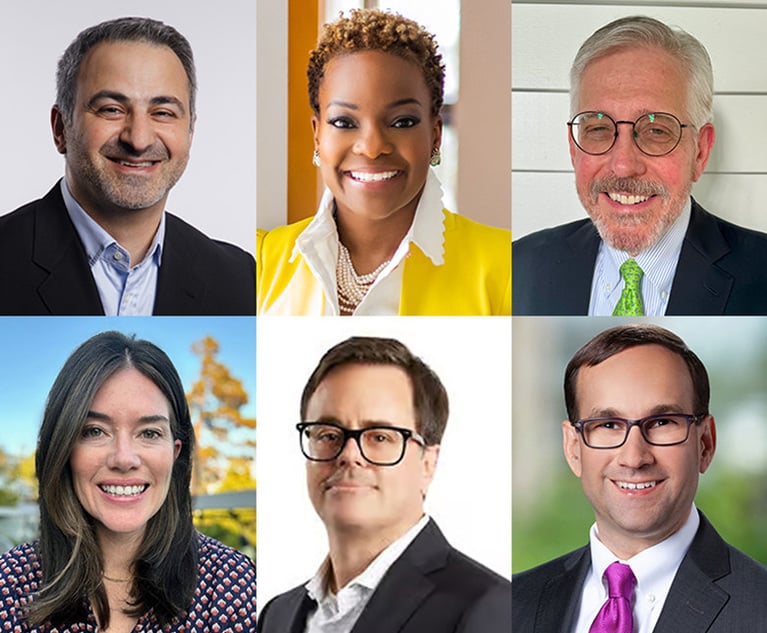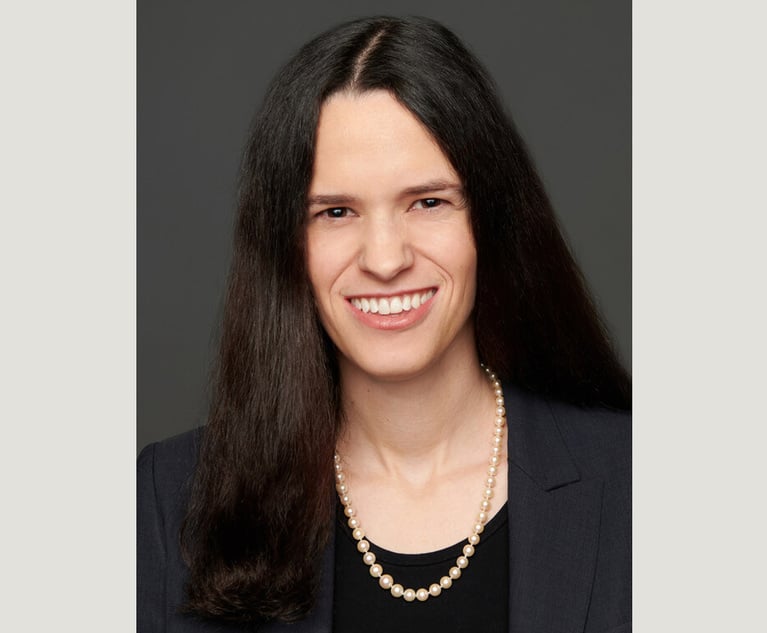Suits against IP firms raise "fair use" questions
Copies of documents may not be protected
April 29, 2012 at 08:00 PM
16 minute read
The lawsuits caught many intellectual property experts by surprise. And for good reason.
The plaintiffs alleged that a well-known, decades-old business practice was, in fact, copyright infringement. Moreover, the alleged infringers were two respected law firms that specialize in IP law.
Plaintiffs sued McDonnell Boehnen Hulbert & Berghoff (MBHB) and Schwegman, Lundberg & Woessner (SLW) for doing what patent firms around the country regularly do—copying articles from scientific and medical journals, and submitting these copies in patent applications as evidence of prior art. The law firms were attempting to comply with the U.S. Patent and Trademark Office (PTO) Rule 56, which requires patent applications to provide all prior art references material to patentability. Failure to provide such references can render any resulting patents unenforceable and expose the patent attorneys to sanctions for ethics violations.
Copying articles for use in patent prosecution “has been done for quite some time. It is a common practice,” says Christopher Larus, a partner at Robins, Kaplan, Miller & Ciresi. “I'm not aware of any controversy around this in the past.”
But there's a controversy now. Two publishers of scientific and medical journals, John Wiley & Sons Ltd. and the American Institute of Physics, want to be paid when law firms copy their articles for patent prosecutions. The publishers assert, in lawsuits filed Feb. 29, that making such copies without authorization is infringement, and are seeking damages and injunctions against both MBHB and SLW.
If the suits are successful, it could significantly affect patent law firms and their clients. Licensing articles would create “additional delays and costs,” says Marcus Thymian, MBHB's managing partner. “And those costs would likely be passed onto patent applicants, which could stifle innovation.”
The effects could reach far beyond the realm of patent practice. A win by the publishers “is likely to have a broad-ranging impact on … lawyers generally submitting materials to the courts,” says Larus. “Law firms that make copies of documents for purposes of submitting them to the courts would look more closely at copyright issues.” As a result, he adds, companies involved in litigation could face significantly increased costs for legal services.
Four Factors
The key issue in these lawsuits is whether the law firms' copying is “fair use” and thus not infringing. To decide that issue, a court must consider the four factors specified by Section 107 of the Copyright Act: the purpose of the copying, the nature of the copyrighted work, the percentage of the work that was copied and the effect of the copying on the market for the copyrighted work.
After reviewing these factors, the general counsel of the PTO concluded that copying articles and submitting them in patent applications was fair use. The Jan. 19 memorandum asserts that “the first factor weighs heavily in favor of fair use” because applicants are “submitting [an article], pursuant to a legal requirement, based on its factual, rather than its expressive, content.” The second factor also favors fair use, because the articles are factual and published. The third factor is neutral because even though articles are typically copied in their entirety, whole articles are often required to provide the information needed in patent applications. The final factor supports fair use because law firms typically obtain the articles from legitimate, licensed databases—so the copyright owners have been paid for the articles. Moreover, the memo declares, “there is no basis for concluding that” submitting the articles to the PTO “has any significant negative impact on the market for the [articles].”
Profit Potential
This memo won't settle the issue. The PTO's interpretation of copyright law is outside the agency's area of expertise—patent and trademark law. It is unclear, therefore, how much weight the courts would give to the agency's pronouncement.
Some experts dispute the PTO's analysis. They assert that law firms make profits by prosecuting patents, so the firms are copying articles for commercial purposes. That would weigh against a finding of fair use.
Moreover, even if PTO regulations require an applicant to submit a copy of a scientific article, “the regulations don't require an applicant to submit an unlicensed copy,” notes William Dunnegan, a partner at Dunnegan & Scileppi. “Paying the copyright owner is just another cost a patent applicant must incur in order to make money by obtaining a patent.”
These arguments, however, don't fit easily with prior court rulings. The relatively few precedents in this area indicate that fair use protects an entity that copies a work without payment and uses the copy in order to seek a legal remedy or other government action. For instance, in Religious Technology Center v. Wollersheim, the 9th Circuit held in 1992 that it was fair use for an attorney representing a client in litigation to copy a work and provide the copy to experts in order to prepare them to testify at trial.
Making Copies
There's another issue: When a law firm copies an article for the PTO, it routinely makes at least one additional copy for its files. Even if the former is protected by fair use, the latter may not be.
The key case in this area is American Geophysical Union v. Texaco Inc. Texaco's researchers copied articles from the plaintiff's scientific journals and placed the copies in their files for later reference. Such copying was not fair use, the 2nd Circuit held in 1995.
That case may be distinguishable. Texaco made copies in order to pursue research, while the law firms made copies in order to help clients comply with PTO requirements. “This is not identical to Texaco,” says Prof. Peter Menell of University of California, Berkeley and Stanford Law Schools.
Many believe MBHB and SLW have a strong argument and should defend their fair use rights in court. “We have been contacted by clients, other law firms, industry organizations, law professors and others who have offered their support,” says MBHB's Thymian.
But going to court would impose significant costs in time and money. Purchasing a license would be much less expensive, at least in the short run. That may be why about half the law firms that received warning letters from the publishers have purchased additional licenses from the publishers, according to a patent attorney familiar with the situation.
And if a law firm goes to court, there's no guarantee it would win. “This is a hard case,” says Menell. “It is not a slam-dunk for either side.”
The lawsuits caught many intellectual property experts by surprise. And for good reason.
The plaintiffs alleged that a well-known, decades-old business practice was, in fact, copyright infringement. Moreover, the alleged infringers were two respected law firms that specialize in IP law.
Plaintiffs sued
Copying articles for use in patent prosecution “has been done for quite some time. It is a common practice,” says Christopher Larus, a partner at
But there's a controversy now. Two publishers of scientific and medical journals, John Wiley & Sons Ltd. and the American Institute of Physics, want to be paid when law firms copy their articles for patent prosecutions. The publishers assert, in lawsuits filed Feb. 29, that making such copies without authorization is infringement, and are seeking damages and injunctions against both MBHB and SLW.
If the suits are successful, it could significantly affect patent law firms and their clients. Licensing articles would create “additional delays and costs,” says Marcus Thymian, MBHB's managing partner. “And those costs would likely be passed onto patent applicants, which could stifle innovation.”
The effects could reach far beyond the realm of patent practice. A win by the publishers “is likely to have a broad-ranging impact on … lawyers generally submitting materials to the courts,” says Larus. “Law firms that make copies of documents for purposes of submitting them to the courts would look more closely at copyright issues.” As a result, he adds, companies involved in litigation could face significantly increased costs for legal services.
Four Factors
The key issue in these lawsuits is whether the law firms' copying is “fair use” and thus not infringing. To decide that issue, a court must consider the four factors specified by Section 107 of the Copyright Act: the purpose of the copying, the nature of the copyrighted work, the percentage of the work that was copied and the effect of the copying on the market for the copyrighted work.
After reviewing these factors, the general counsel of the PTO concluded that copying articles and submitting them in patent applications was fair use. The Jan. 19 memorandum asserts that “the first factor weighs heavily in favor of fair use” because applicants are “submitting [an article], pursuant to a legal requirement, based on its factual, rather than its expressive, content.” The second factor also favors fair use, because the articles are factual and published. The third factor is neutral because even though articles are typically copied in their entirety, whole articles are often required to provide the information needed in patent applications. The final factor supports fair use because law firms typically obtain the articles from legitimate, licensed databases—so the copyright owners have been paid for the articles. Moreover, the memo declares, “there is no basis for concluding that” submitting the articles to the PTO “has any significant negative impact on the market for the [articles].”
Profit Potential
This memo won't settle the issue. The PTO's interpretation of copyright law is outside the agency's area of expertise—patent and trademark law. It is unclear, therefore, how much weight the courts would give to the agency's pronouncement.
Some experts dispute the PTO's analysis. They assert that law firms make profits by prosecuting patents, so the firms are copying articles for commercial purposes. That would weigh against a finding of fair use.
Moreover, even if PTO regulations require an applicant to submit a copy of a scientific article, “the regulations don't require an applicant to submit an unlicensed copy,” notes William Dunnegan, a partner at Dunnegan & Scileppi. “Paying the copyright owner is just another cost a patent applicant must incur in order to make money by obtaining a patent.”
These arguments, however, don't fit easily with prior court rulings. The relatively few precedents in this area indicate that fair use protects an entity that copies a work without payment and uses the copy in order to seek a legal remedy or other government action. For instance, in Religious Technology Center v. Wollersheim, the 9th Circuit held in 1992 that it was fair use for an attorney representing a client in litigation to copy a work and provide the copy to experts in order to prepare them to testify at trial.
Making Copies
There's another issue: When a law firm copies an article for the PTO, it routinely makes at least one additional copy for its files. Even if the former is protected by fair use, the latter may not be.
The key case in this area is American Geophysical Union v.
That case may be distinguishable. Texaco made copies in order to pursue research, while the law firms made copies in order to help clients comply with PTO requirements. “This is not identical to Texaco,” says Prof. Peter Menell of University of California, Berkeley and Stanford Law Schools.
Many believe MBHB and SLW have a strong argument and should defend their fair use rights in court. “We have been contacted by clients, other law firms, industry organizations, law professors and others who have offered their support,” says MBHB's Thymian.
But going to court would impose significant costs in time and money. Purchasing a license would be much less expensive, at least in the short run. That may be why about half the law firms that received warning letters from the publishers have purchased additional licenses from the publishers, according to a patent attorney familiar with the situation.
And if a law firm goes to court, there's no guarantee it would win. “This is a hard case,” says Menell. “It is not a slam-dunk for either side.”
This content has been archived. It is available through our partners, LexisNexis® and Bloomberg Law.
To view this content, please continue to their sites.
Not a Lexis Subscriber?
Subscribe Now
Not a Bloomberg Law Subscriber?
Subscribe Now
NOT FOR REPRINT
© 2025 ALM Global, LLC, All Rights Reserved. Request academic re-use from www.copyright.com. All other uses, submit a request to [email protected]. For more information visit Asset & Logo Licensing.
You Might Like
View All
Advertising Tech Likely to Draw More Scrutiny in 2025 Over Consumers' Data, Lawyers Say
5 minute read

'Be Comfortable Being Uncomfortable': Pearls of Wisdom From 2024 GC Q&As

In-House Moves of the Month: Boeing Loses Another Lawyer, HubSpot Legal Chief Out After 2 Years
5 minute readTrending Stories
- 1Deal Watch: Latham, Paul Weiss, Debevoise Land on Year-End Big Deals. Plus, Mixed Messages for 2025 M&A
- 2Bathroom Recording Leads to Lawyer's Disbarment: Disciplinary Roundup
- 3Conn. Supreme Court: Workers' Comp Insurance Cancellations Must Be Unambiguous
- 4To Avoid Conflict, NYAG Hands Probe Into Inmate's Beating Death to Syracuse-Area DA
- 5Scripture-Quoting Employee Sues Company for Supporting LGBTQ Pride
Who Got The Work
Michael G. Bongiorno, Andrew Scott Dulberg and Elizabeth E. Driscoll from Wilmer Cutler Pickering Hale and Dorr have stepped in to represent Symbotic Inc., an A.I.-enabled technology platform that focuses on increasing supply chain efficiency, and other defendants in a pending shareholder derivative lawsuit. The case, filed Oct. 2 in Massachusetts District Court by the Brown Law Firm on behalf of Stephen Austen, accuses certain officers and directors of misleading investors in regard to Symbotic's potential for margin growth by failing to disclose that the company was not equipped to timely deploy its systems or manage expenses through project delays. The case, assigned to U.S. District Judge Nathaniel M. Gorton, is 1:24-cv-12522, Austen v. Cohen et al.
Who Got The Work
Edmund Polubinski and Marie Killmond of Davis Polk & Wardwell have entered appearances for data platform software development company MongoDB and other defendants in a pending shareholder derivative lawsuit. The action, filed Oct. 7 in New York Southern District Court by the Brown Law Firm, accuses the company's directors and/or officers of falsely expressing confidence in the company’s restructuring of its sales incentive plan and downplaying the severity of decreases in its upfront commitments. The case is 1:24-cv-07594, Roy v. Ittycheria et al.
Who Got The Work
Amy O. Bruchs and Kurt F. Ellison of Michael Best & Friedrich have entered appearances for Epic Systems Corp. in a pending employment discrimination lawsuit. The suit was filed Sept. 7 in Wisconsin Western District Court by Levine Eisberner LLC and Siri & Glimstad on behalf of a project manager who claims that he was wrongfully terminated after applying for a religious exemption to the defendant's COVID-19 vaccine mandate. The case, assigned to U.S. Magistrate Judge Anita Marie Boor, is 3:24-cv-00630, Secker, Nathan v. Epic Systems Corporation.
Who Got The Work
David X. Sullivan, Thomas J. Finn and Gregory A. Hall from McCarter & English have entered appearances for Sunrun Installation Services in a pending civil rights lawsuit. The complaint was filed Sept. 4 in Connecticut District Court by attorney Robert M. Berke on behalf of former employee George Edward Steins, who was arrested and charged with employing an unregistered home improvement salesperson. The complaint alleges that had Sunrun informed the Connecticut Department of Consumer Protection that the plaintiff's employment had ended in 2017 and that he no longer held Sunrun's home improvement contractor license, he would not have been hit with charges, which were dismissed in May 2024. The case, assigned to U.S. District Judge Jeffrey A. Meyer, is 3:24-cv-01423, Steins v. Sunrun, Inc. et al.
Who Got The Work
Greenberg Traurig shareholder Joshua L. Raskin has entered an appearance for boohoo.com UK Ltd. in a pending patent infringement lawsuit. The suit, filed Sept. 3 in Texas Eastern District Court by Rozier Hardt McDonough on behalf of Alto Dynamics, asserts five patents related to an online shopping platform. The case, assigned to U.S. District Judge Rodney Gilstrap, is 2:24-cv-00719, Alto Dynamics, LLC v. boohoo.com UK Limited.
Featured Firms
Law Offices of Gary Martin Hays & Associates, P.C.
(470) 294-1674
Law Offices of Mark E. Salomone
(857) 444-6468
Smith & Hassler
(713) 739-1250






